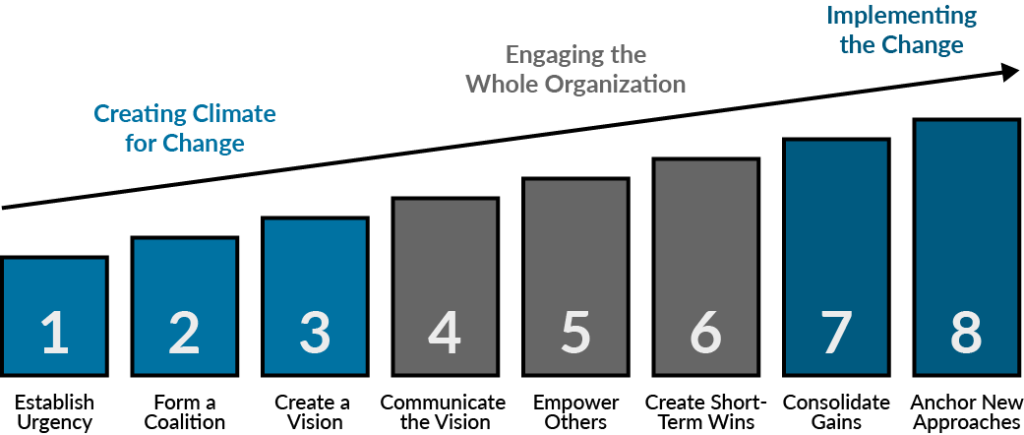Kotter: 8 -Step Change Model
8-Step Change Model by John Kotter is a framework for managing change within an organization. The model provides a step-by-step approach for leading and implementing successful change initiatives.
The eight steps in the model are:

- Establish a sense of urgency: Create a compelling reason for why change is necessary and urgent.
- Form a powerful coalition: Build a team of influential people who are committed to the change effort.
- Create a vision for change: Develop a clear and inspiring vision that communicates the desired outcome of the change effort.
- Communicate the vision: Share the vision with everyone in the organization and ensure that they understand it.
- Empower others to act on the vision: Remove obstacles and empower individuals to take action towards the change.
- Create short-term wins: Celebrate successes along the way to maintain momentum and motivate the team.
- Consolidate gains and produce more change: Use the momentum from early successes to continue making progress towards the desired change.
- Anchor new approaches in the organization’s culture: Embed the new behaviors and approaches in the organization’s culture to ensure the change is sustained over time.
The Kotter 8-Step Change Model is a useful framework for organizations to follow when implementing change. Here are some reasons why it is considered useful:
- Structured approach: The model provides a structured approach to change management, breaking it down into eight clear steps. This helps to ensure that nothing is overlooked or forgotten during the change process.
- Clear direction: Each step of the model provides clear direction on what needs to be done and when, making it easier for everyone involved to understand their role and responsibilities in the change process.
- Emphasis on communication: The model places a strong emphasis on communication, both within the organization and with external stakeholders. This is important because effective communication is critical for building support and buy-in for the change.
- Flexibility: While the model provides a clear framework, it is also flexible enough to be adapted to different types of changes and different organizational contexts.
- Focus on leadership: The model places a strong emphasis on leadership throughout the change process. This is important because effective leadership is critical for inspiring and guiding employees through the change.
In general, leaders seeking to implement organizational change can benefit greatly from utilizing Kotter’s 8-step change model. This approach allows leaders to concentrate on the most crucial elements of leading change, adopts a comprehensive perspective, and is versatile enough to be modified to fit any organization’s unique needs.